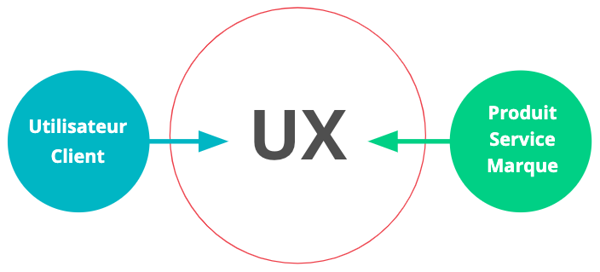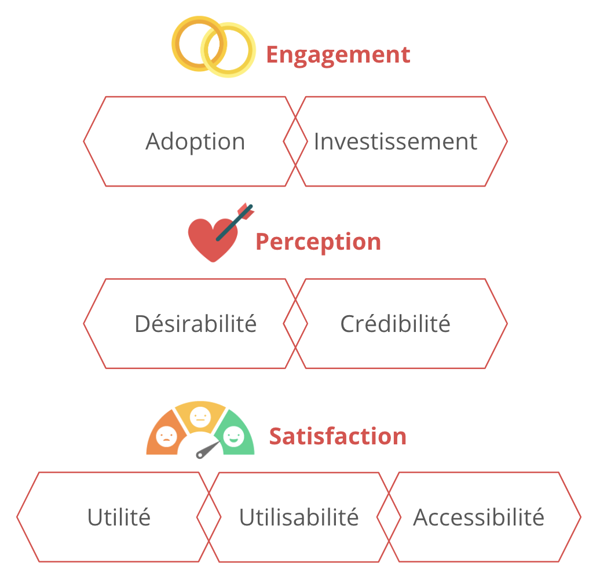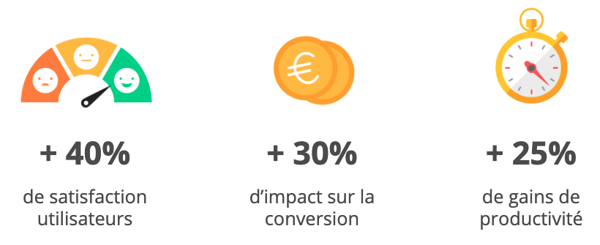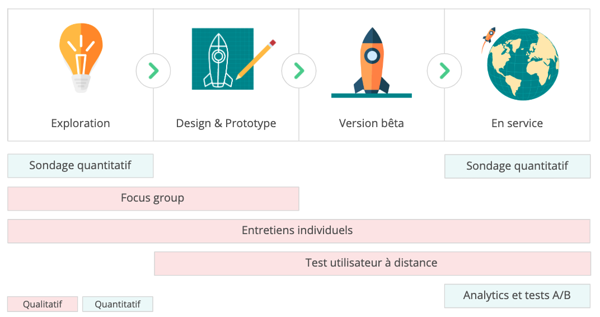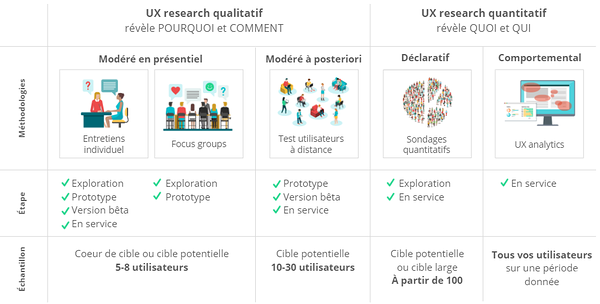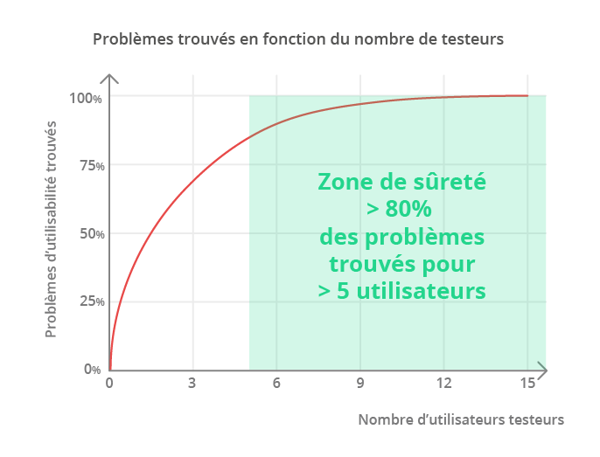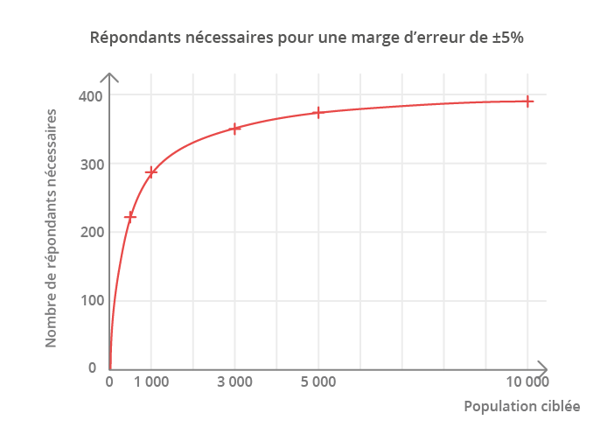December 17, 2019
All about user research: qualitative and quantitative UX study
UX research is the set of tools used to design user-centered products and services. Let's take a look at the different types of qualitative and quantitative studies that will allow you to create a quality user experience.
Let's start with some definitions around user research
What's User Experience?
User Experience (UX) refers to a person's experience and attitude when using a product or service. This includes operational scope, brand, psychological expectations and emotions. They are crucial parts of the user experience.UX is the interaction between the user/customer and the product/service/brand.
What's UX Research?
UX research is the regular inquiry of users and their demands, to add context and first-hand knowledge to the user experience design process. It can be a qualitative or quantitative study, depending on the needs and situations.UX research is not a technical formula, although some bugs can be found.
UX research is not a theoretical approach either. Its purpose is to reveal specific facts from pragmatic everyday experiences and not abstract principles or theories. It is applied research.
UX Research analyzes your product or service based on 7 aspects:
- Utility: does your experience meet the users' needs?
- Usability: how is your experience handled by users?
- Accessibility: is it accessible to all types of users?
- Attractiveness: is your experience attractive to users?
- Credibility: does it give users confidence?
- Adoption: does your experience make users want to subscribe/use your service/product?
- Investment: is your experience sustainable for users?
What is a Qualitative UX Study?
Qualitative UX research is the study of human behavior focusing on context and detailed observation rather than on statistical data.Examples of qualitative methodologies:
- Individual Interview
- Focus groups
- Remote User Tests
What is a Quantitative UX study?
Quantitative UX research is the study of human behavior focusing on statistical data.Examples of quantitative methodologies:
- Survey
- A/B test or multi-varied test
- Heatmap
Why Conduct User Experience Studies?
UX research allows you to improve your customer satisfaction, your conversion and your productivity. It is a determining factor of success."When we started talking to our users and understanding how they were using our service, that was the turning point in our company's success"88% of internet users buying online say they do not return to a website after a bad experience (statistics from Amazon Web Services).
- Joe Gebbia, Co-founder of Airbnb
At the same time, 70% of online companies go out of business due to poor usability (Uxeria statistics).
Qualitative or Quantitative Study? Which methodology to choose?
Choose according to your objectives
Quantitative research allows to identify blocking points. It focuses on the "What" and "Who". Qualitative research allows you to understand and resolve the blocking points. It allows to identify the "Why" and the "How".Choose according to the development stage
In order to progress confidently, each stage needs to be confronted from a user's point of view. However, some methodologies are more efficient or adapted to the development stage of your product or service.Qualitative studies allow to test ideas or prototypes at a very early stage. Since the data collected is qualitative, it is easy to isolate feedback caused by comprehension or prototyping bias, while keeping the real blocking points in mind.
The golden rule: the earlier you start UX research, the less costly the adjustment. Modifying an idea or a strategy is easier than modifying a prototype, which is easier to modify than a finished product.> Test our tool to find the study adapted to your needs
How to Conduct Qualitative and/or Quantitative Studies?
The entire user experience research can be summarized by the table below:Moderate Face-to-Face Qualitative Study: Individual interviews and focus groups
Why: To reveal WHY and HOW blocking points in the user experience.When: Throughout the process, as soon and as often as possible
Whom: 5-8 core target users
What:
- Exploration & Ideation
- Prototype Testing
- Beta Version Testing
- Marketed Product or Service Testing
Curve N (1-(1- L ) ^n ) with L (average proportion of usability problems found per user) = 31% calculated by Jakob Nielsen's teams. This 31% value can be used for face-to-face user tests with advanced targeting profiles and a low diversity of devices tested.
> Learn more about individual interviews (deliverables, objectives, process...)
> Learn more about focus groups (deliverables, objectives, process...)
Moderate Qualitative Study Afterwards: Remote user tests
Why: To reveal the WHY and HOW of blocking pointsWhen: As soon as you have some elements to show, and then as often as you can
Whom: 10 - 30 users depending on your targeting level
What:
- Prototype Testing
- Beta Version Testing
- Marketed Product or Service Testing
Jakob Nielsen's curve N (1-(1- L ) ^n ) with L = 16%.
For remote testing methodology, we recommend using a value of L at 16% to ensure the results' accuracy (L being the average of the proportion of usability problems found per user). In fact, moderation afterwards makes this methodology less "deep" than a face-to-face user test for which L = 31% is used.
> Learn more about remote testing (deliverables, objectives, process...)Quantitative Study in Active Collection: Survey
Why: To reveal WHAT the blocking points ARE and for WHOMWhen: Before the project to identify your target or your competition. After the project to understand the uses.
Whom: 400 representative users (using the quota method) for a national target. 300 may be enough for a standard target of the "French".
What:
- Exploration
- On a marketed product or service
> Learn more about the quantitative survey (deliverables, objectives, process...)
Quantitative Study in Passive Collection: UX analytics
Why: To reveal WHAT the blocking points ARE and for WHOMWhen: Once your digital product is up and running
Whom: All your users
What: Optimization of a digital product in service
In conclusion
UX research is a key success factor and should be initiated at all stages of your project development and as soon as possible.If you wish to improve your users' and customers' experience, Ferpection can assist you throughout the process. Do not hesitate to contact us for a free custom-made quote!
All articles from the category: User research | RSS
